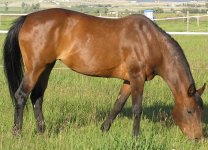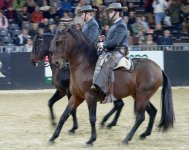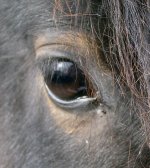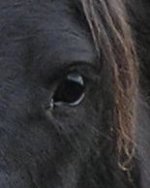♘امیرحسین♞
♘ مدیریت انجمن اسب ایران ♞
Bay is a hair coat color of horses, characterized by a reddish brown body color with a black mane, tail and lower legs. Bay is one of the most common coat colors in many horse breeds.
The black areas of a bay horse's hair coat are called "black points." Black points always include the mane and tail, almost always include the lower legs (unless covered by white markings), and may also be found on the tips of the ears. Bay horses usually have black skin under their hair coat, except beneath white markings.
Color shade variations
Bay horses range in color from a light copper red, to a rich red blood bay (the best-known variety of bay horse) to a very dark red or brown called either dark bay, mahogany bay, black-bay, or simply brown. Some bay horses will exhibit dappling, a faint pattern of concentric rings within the coat, usually only appearing on a summer coat, considered a sign of a healthy horse in good condition, though the tendency to dapple may also be, to some extent, inborn, as many well-conditioned bay horses do not dapple.
Many light bays and blood bays have a two-toned hair shaft, which, if shaved too closely (such as when body-clipping for a horse show), may cause the horse to appear several shades lighter, a somewhat dull orange-gold, almost like a dun. However, as the hair grows out, it will darken again to the proper shade. This phenomenon is usually not seen in dark bays.
Other variations
A few bay horses may carry the rabicano gene, which can cause some white or cream hairs to appear in the mane or tail, sometimes creating a "skunk" effect. Some bay horses, particularly Clydesdales, may exhibit sabino traits and exhibit slight body spotting.
"Brown" horses
Some breed registries (including the Jockey Club Thoroughbred registry) use the term "brown" to describe dark bays, though genetically, bay and brown horses both have a black (E) gene suppressed into black points by the agouti (A) gene. However, "liver" chestnuts, horses with a red or brown mane and tail as well as a dark brownish body coat, are also sometimes called "brown." Therefore,"brown" is an ambiguous term for describing horse coat color. It is preferable to refer to dark-colored horses as dark bays or liver chestnuts.
Colors that are not bay
For description of other coat colors, see Equine coat color.
* Buckskin horses have a black mane and tail, but instead of a red or brown coat, they have a cream or gold coat. Though once called a "Sandy" bay in some texts on horse color, the genetic distinction created by the cream gene is significant. Buckskins are seldom mistaken for bays because their coats are significantly lighter and have no hint of a red or orange tint.
* Chestnuts have a reddish body coat like a bay, but their manes and tails are the same shade as their body color or even a few shades lighter--never black.
* Black are occasionally confused with dark bays and liver chestnuts because some black horses "sunburn," that is, when kept out in the sun, they develop a bleached-out coat that looks brownish. However, a true black can be recognized by looking at the fine hairs around the muzzle and eyes. These hairs are always black on a black horse, but are reddish, brownish, or even a light gold on a bay or chestnut.
* Roan horses sometimes have a bay base coat, but the roan gene creates an effect of white hairs intermingled with the red body coat. Such horses are called bay roans or, less accurately, red roans, but they are not bay horses even though they have a predominantly red body coat with a black mane and tail.
* Pinto horses also may have a bay base coat overlaid by white spots. However, these horses are pinto, not bay. Sometimes the term Skewbald is used, especially in the UK, to refer to bay and white pintos.
Genetics
Equine coat color genetics are complex, but a simple explanation of bay color begins with the understanding that "red" color, such as that of the chestnut horse, represented by the recessive "e" gene, and black color, represented by the somewhat more dominant "E" gene are the two most basic coat colors genes.
Unlike other types of "point" coloring, such as that seen in Siamese cats, the black points characteristic of bay coloring are not produced by a dilution or albinism gene. Instead, a bay horse carries both the Extension gene (E) and a suppression gene known as the agouti gene (A). The extension gene, also sometimes called the "black" gene, adds black color to the coat and the agouti gene, dominant over the black gene, limits or suppresses the black coloring to black points, allowing the underlying red coat color to come through.
Simply put, if a horse lacks the agouti (A) gene, it is completely black. If a horse lacks the extension (or black) gene (E), it will be chestnut or "sorrel." A chestnut may produce bays when bred to black or bay horses, and a black horse may produce bays when bred to bay or chestnut horses who carry the Agouti gene.
If a horse carrying the extension and agouti genes additionally has a heterozygous dilution gene, also called the "cream gene," it will have the buckskin color, which is similar to bay except that red or brown areas are lightened to a yellow or gold shade. If the horse has a homozygous cream gene, it will have a perlino color, where the black points become reddish, and red areas appear nearly white.
Because the extension (E) gene and agouti (A) gene can be either heterozygous or homozygous, the extent to which a bay passes on its color varies widely from one horse to another depending on its genotype and that of its mate. All the combination of genes below are possible and all relatively common, making bay breedings hard to predict without a prior DNA blood test for color-related genes.:
* Ee Aa bay × aa chestnut: 25% bay, 25% black, 50% chestnut
* Ee Aa bay × Ee black: 37.5% bay, 37.5% black, 25% chestnut
* Ee Aa bay × EE black: 50% bay, 50% black
* Ee Aa bay × Ee Aa bay: 56.25% bay, 18.75% black, 25% chestnut
* Ee Aa bay × EE Aa bay: 75% bay, 25% black
* Ee Aa bay × Ee AA bay: 75% bay, 25% chestnut
* Ee Aa bay × EE AA bay: 100% bay
* Ee Aa bay × aa chestnut: 25% bay, 25% black, 50% chestnut
* Ee Aa bay × aa chestnut 25% bay, 25% black, 50% chestnut
* EE Aa bay × Aa chestnut/black: 50% bay, 50% black
* EE Aa bay × Aa bay: 75% bay, 25% black
* EE Aa bay × AA bay: 100% bay
* Ee AA bay × AA chestnut: 50% bay, 50% chestnut
* Ee AA bay × Ee bay/black: 75% bay, 25% chestnut
* Ee AA bay × EE bay/black: 100% bay
* EE AA bay × chestnut/bay/black: 100% bay
The black areas of a bay horse's hair coat are called "black points." Black points always include the mane and tail, almost always include the lower legs (unless covered by white markings), and may also be found on the tips of the ears. Bay horses usually have black skin under their hair coat, except beneath white markings.
Color shade variations
Bay horses range in color from a light copper red, to a rich red blood bay (the best-known variety of bay horse) to a very dark red or brown called either dark bay, mahogany bay, black-bay, or simply brown. Some bay horses will exhibit dappling, a faint pattern of concentric rings within the coat, usually only appearing on a summer coat, considered a sign of a healthy horse in good condition, though the tendency to dapple may also be, to some extent, inborn, as many well-conditioned bay horses do not dapple.
Many light bays and blood bays have a two-toned hair shaft, which, if shaved too closely (such as when body-clipping for a horse show), may cause the horse to appear several shades lighter, a somewhat dull orange-gold, almost like a dun. However, as the hair grows out, it will darken again to the proper shade. This phenomenon is usually not seen in dark bays.
Other variations
A few bay horses may carry the rabicano gene, which can cause some white or cream hairs to appear in the mane or tail, sometimes creating a "skunk" effect. Some bay horses, particularly Clydesdales, may exhibit sabino traits and exhibit slight body spotting.
"Brown" horses
Some breed registries (including the Jockey Club Thoroughbred registry) use the term "brown" to describe dark bays, though genetically, bay and brown horses both have a black (E) gene suppressed into black points by the agouti (A) gene. However, "liver" chestnuts, horses with a red or brown mane and tail as well as a dark brownish body coat, are also sometimes called "brown." Therefore,"brown" is an ambiguous term for describing horse coat color. It is preferable to refer to dark-colored horses as dark bays or liver chestnuts.
Colors that are not bay
For description of other coat colors, see Equine coat color.
* Buckskin horses have a black mane and tail, but instead of a red or brown coat, they have a cream or gold coat. Though once called a "Sandy" bay in some texts on horse color, the genetic distinction created by the cream gene is significant. Buckskins are seldom mistaken for bays because their coats are significantly lighter and have no hint of a red or orange tint.
* Chestnuts have a reddish body coat like a bay, but their manes and tails are the same shade as their body color or even a few shades lighter--never black.
* Black are occasionally confused with dark bays and liver chestnuts because some black horses "sunburn," that is, when kept out in the sun, they develop a bleached-out coat that looks brownish. However, a true black can be recognized by looking at the fine hairs around the muzzle and eyes. These hairs are always black on a black horse, but are reddish, brownish, or even a light gold on a bay or chestnut.
* Roan horses sometimes have a bay base coat, but the roan gene creates an effect of white hairs intermingled with the red body coat. Such horses are called bay roans or, less accurately, red roans, but they are not bay horses even though they have a predominantly red body coat with a black mane and tail.
* Pinto horses also may have a bay base coat overlaid by white spots. However, these horses are pinto, not bay. Sometimes the term Skewbald is used, especially in the UK, to refer to bay and white pintos.
Genetics
Equine coat color genetics are complex, but a simple explanation of bay color begins with the understanding that "red" color, such as that of the chestnut horse, represented by the recessive "e" gene, and black color, represented by the somewhat more dominant "E" gene are the two most basic coat colors genes.
Unlike other types of "point" coloring, such as that seen in Siamese cats, the black points characteristic of bay coloring are not produced by a dilution or albinism gene. Instead, a bay horse carries both the Extension gene (E) and a suppression gene known as the agouti gene (A). The extension gene, also sometimes called the "black" gene, adds black color to the coat and the agouti gene, dominant over the black gene, limits or suppresses the black coloring to black points, allowing the underlying red coat color to come through.
Simply put, if a horse lacks the agouti (A) gene, it is completely black. If a horse lacks the extension (or black) gene (E), it will be chestnut or "sorrel." A chestnut may produce bays when bred to black or bay horses, and a black horse may produce bays when bred to bay or chestnut horses who carry the Agouti gene.
If a horse carrying the extension and agouti genes additionally has a heterozygous dilution gene, also called the "cream gene," it will have the buckskin color, which is similar to bay except that red or brown areas are lightened to a yellow or gold shade. If the horse has a homozygous cream gene, it will have a perlino color, where the black points become reddish, and red areas appear nearly white.
Because the extension (E) gene and agouti (A) gene can be either heterozygous or homozygous, the extent to which a bay passes on its color varies widely from one horse to another depending on its genotype and that of its mate. All the combination of genes below are possible and all relatively common, making bay breedings hard to predict without a prior DNA blood test for color-related genes.:
* Ee Aa bay × aa chestnut: 25% bay, 25% black, 50% chestnut
* Ee Aa bay × Ee black: 37.5% bay, 37.5% black, 25% chestnut
* Ee Aa bay × EE black: 50% bay, 50% black
* Ee Aa bay × Ee Aa bay: 56.25% bay, 18.75% black, 25% chestnut
* Ee Aa bay × EE Aa bay: 75% bay, 25% black
* Ee Aa bay × Ee AA bay: 75% bay, 25% chestnut
* Ee Aa bay × EE AA bay: 100% bay
* Ee Aa bay × aa chestnut: 25% bay, 25% black, 50% chestnut
* Ee Aa bay × aa chestnut 25% bay, 25% black, 50% chestnut
* EE Aa bay × Aa chestnut/black: 50% bay, 50% black
* EE Aa bay × Aa bay: 75% bay, 25% black
* EE Aa bay × AA bay: 100% bay
* Ee AA bay × AA chestnut: 50% bay, 50% chestnut
* Ee AA bay × Ee bay/black: 75% bay, 25% chestnut
* Ee AA bay × EE bay/black: 100% bay
* EE AA bay × chestnut/bay/black: 100% bay




